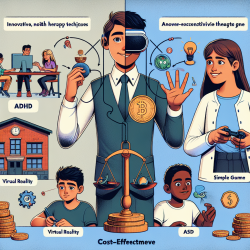In the evolving landscape of special education and therapy, online therapy services like those provided by TinyEYE are increasingly pivotal. One promising approach is electronic mentoring (e-mentoring), which has been systematically reviewed in the research article "Electronic Mentoring Programs and Interventions for Children and Youth With Disabilities: Systematic Review" by Eysenbach et al. This blog aims to guide practitioners on how to implement the outcomes of this research to enhance their online therapy services.
The Potential of E-Mentoring
According to the systematic review, e-mentoring is defined as a computer-mediated, mutually beneficial relationship between a mentor and a protégé. This format reduces physical barriers, making mentoring more accessible for youth with disabilities. The review synthesized findings from 25 studies, involving 897 participants aged 12-26 years, across six countries. The outcomes were overwhelmingly positive, with 81% of studies reporting significant improvements in areas such as career decision-making, self-determination, self-advocacy, self-confidence, self-management, social skills, attitude toward disability, and coping with daily life.
Implementing E-Mentoring in Online Therapy
For practitioners, integrating e-mentoring into online therapy services can offer multiple benefits:
- Enhanced Accessibility: E-mentoring leverages various delivery formats such as interactive websites, virtual environments, email, mobile apps, Skype video calls, and phone calls. This flexibility can cater to the diverse needs of youth with different disabilities.
- Improved Outcomes: The review highlighted significant improvements in self-determination, self-advocacy, and self-confidence among participants. These are crucial areas for youth with disabilities as they transition to adulthood.
- Social and Emotional Support: E-mentoring provides a platform for social interaction and peer support, which can reduce feelings of isolation and improve social skills.
Designing Effective E-Mentoring Programs
To create effective e-mentoring programs, consider the following elements:
- Delivery Format: Choose a format that suits your participants' needs. Interactive websites and Skype calls were particularly effective in the reviewed studies.
- Mentor Selection: Match mentors and mentees based on shared experiences or similar disabilities. This can foster a more relatable and supportive relationship.
- Program Duration: While the optimal duration varied, both short-term and long-term programs showed positive outcomes. Tailor the program length to the specific goals and needs of your participants.
Encouraging Further Research
While the findings are promising, the review also highlighted the need for more rigorously designed studies to better understand the impact and effective components of e-mentoring interventions. Practitioners are encouraged to contribute to this growing body of research by evaluating their own programs and sharing their findings.
To read the original research paper, please follow this link: Electronic Mentoring Programs and Interventions for Children and Youth With Disabilities: Systematic Review.










